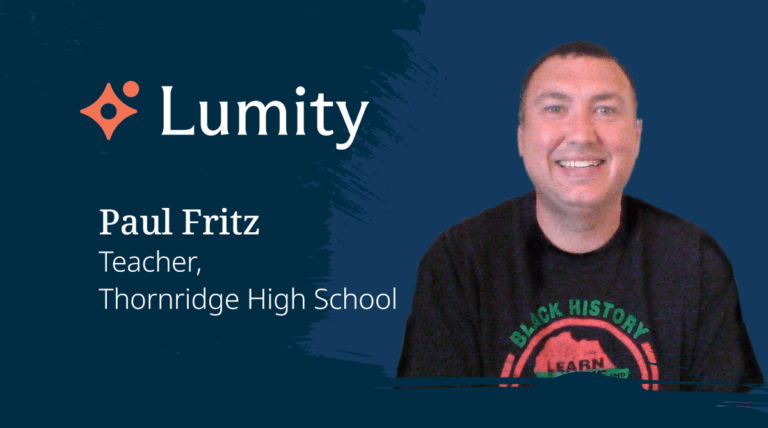Teacher Paul Fritz On Teaching During COVID and Lumity
Thornridge High School in Chicago’s South Suburbs is one of Lumity’s STEM Career Prep partners. During this past school year, the Lumity team worked weekly with Chemistry teacher Paul Fritz and his students in a variety of hands-on STEM career experiences. We caught up with Paul to debrief the year and celebrate our classroom partnership.
Lumity: Mr. Fritz, we really enjoyed working with you and your students this year. When you reflect on the year, what stands out for you? Is there one story that you think exemplifies what our work together is all about?
Mr. Fritz: I enjoyed working with your facilitators [Raheed Davis and Simone Smith] also, and, of course, the Lumity STEMFair is a highlight. If I were to pinpoint an example, one particular student comes to mind. The student joined my chemistry class second semester after having a lot of trouble at the beginning of the year. She had a lot of absences first semester, got in trouble in January, and then was out for two weeks. But after a few weeks in my class, you could tell she started to buy into the STEM projects she was doing with Simone and Raheed. She was engaged with the Lumity activities and that carried over to chemistry also. This student went from having attendance problems last fall to sign up for Lumity’s summer STEM program. It’s a great example of our work together.
Lumity: That’s a terrific example, and we all know that many students struggled to be back at school in person after being out for so long. Could you share your experience and perspective on the implications of the pandemic on student learning?
Mr. Fritz: It really was a big challenge coming back this year. Because we had been entirely remote last year, most of my 10th graders never stepped into a high school building. They missed out on the whole 9th-grade experience when relationships, norms, and expectations are established, and you could see it had impacted their learning and social skills.
Lumity: I know we worked together to address these challenges. What were some of the strategies that you think helped move the needle – or helped reorient and re-engage kids in learning after being remote?
Mr. Fritz: We needed to get back to having kids do and understand science, not just knowing how to find an answer. Yes, kids have great tech skills to find any answer they need, but do they understand the processes and steps involved in doing science and can they work with others through a process? [Lumity facilitators] Simone and Raheed did a great job helping students experience the process of scientific thinking and showing how those skills are important in the real world. In one activity where students built a prosthetic hand, you could see them problem-solving, trying different approaches, working through their frustration, and figuring out what to do differently. This is much more important than just finding an answer.
Lumity: I think we share the belief that real-world applications of STEM are critical for inspiring students. Our business volunteers from PwC and Jabian Consulting spent some time volunteering with your students. How do you think students benefit from these interactions with STEM professionals?
Mr. Fritz: The business volunteers were so helpful in giving students an understanding of the skills they need beyond high school and in business. Their feedback on students’ presentations, as an example, pushed students beyond what they usually did. Yes, you can give a presentation, but can you give it in an entertaining manner? Can you do it without looking at your slides? Can you answer follow-up questions? This is exactly the type of specific feedback students need to develop their skills and prepare for college and careers.
